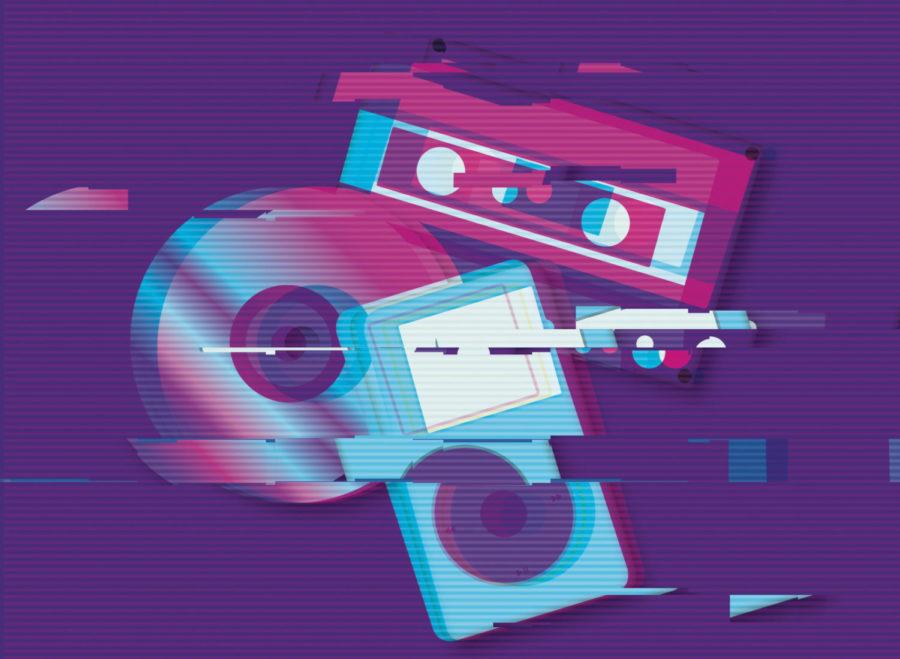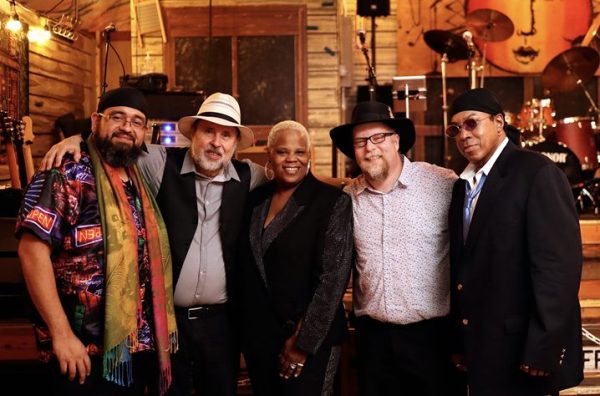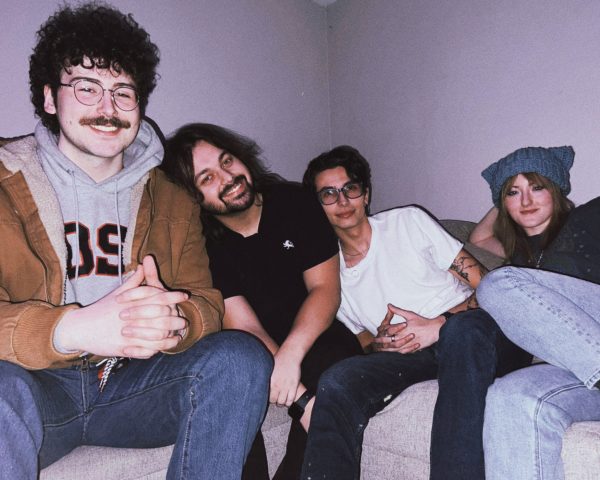Sadness gone viral: Nostalgia and heartbreak dominate charts
nostalgia music vaporwave
March 12, 2019
Music has become progressively more depressing since the 1990s and throughout the early 2010s. Since 2017, the mood of popular music of all types has been on a downward spiral, but there is also a trend in the Internet-based creation of various microgenres playing on the anxieties and nostalgia of Millennials and Generation Z. This sadness is accompanied by an immense wave of nostalgia, taking over music and almost every other form of media.
Various other media outlets have raised concerns about this increase in sadness, including the alternative music publication Pitchfork. Their articles mention the sadness embedded within the music but hardly tackle the reasons behind why the music is sad or to what extent the sadness goes.
An analysis of the Year End Charts for the Billboard Hot 100 from its inception in 2006 to 2018 shows a sudden spike in sad music around 2016. The lowest number of sad songs per year were in the years 2010-2014 while the highest were in 2009, 2017 and 2018. 2018 and 2017 overshadow 2009 at nineteen and eighteen sad songs each.
Songs filled with regret, loneliness, drug addictions and even suicidal thoughts have taken residence on the Billboard Hot 100 charts more often in the past two years than in years prior to 2017. One of the highest charting songs of 2017, “1-800-273-8255” by Logic, Alessia Cara and Khalid, embodied the trend of sad sounds or messages.
The title of the song references the telephone number for the National Suicide Prevention Lifeline. The lyrics deal with depression, hardships and the desire to end one’s life and the waning of those thoughts over time.
Even songs titled “Happier” have sad messages. In this case, “Happier,” the collaboration between EDM superstar Marshmello and indie-pop group Bastille, is about ending a relationship to free the other person in hopes that they will be happier with someone else.
This sadness “bug” has infected many other genres outside of the charts as well. This is especially true of hip-hop.
Artists such as Lil Uzi Vert, JUICE WRLD and XXXTentacion have paved the way for this sad sound in hip-hop over the past few years. XXXTenatacion is best known, outside of his domestic abuse scandals and murder, for songs such as “Sad!” and “Moonlight.”
The former contains the lyric, “Who am I? Someone that’s afraid to let go, uh/You decide, if you’re ever gonna let me know, yeah/Suicide, if you ever try to let go, uh.”
Lil Uzi Vert entered the mainstream hip hop scene on his single titled “XO TOUR Llif3,” which contained the lyrics, “Push me to the edge/All my friends are dead.”
In an email, Catherine John, an associate professor at the University of Oklahoma, said she agreed that these songs were reflective of this “sadness trend.” She offered a quote from David Banner, an American rap artist and producer, in which he said, “Hip-hop reflects the state of America, but America makes it look a lot prettier.”
As hip-hop has become more commercially dominant, John said it has embodied a more commercial sound and message. While it’s role at its conception was to be “both a social and cultural expression which has political grievances,” John said “the take over by big record companies, the use of the music to sell advertising and sports, the advent of soundscan, all of these things collectively compromised [the genre].” Despite this, she said this function of hip-hop is not lost and still exists.
“Underground rappers still seem to be saying a lot,” John said.
There are social critiques that find their way into the mainstream, however, most notably “This Is America” by Childish Gambino. Released in the summer of 2018, the song made waves on social media and focused the national zeitgeist on the plight of black Americans in the modern day. It mentions the vapid sound of commercial rap, police brutality, media and went on to take home four awards at the Grammys, including Song of the Year and Record of the Year.
The social critiques of “This Is America” are present in the works of other artists that have come out recently. One of these works was an album by the British indie pop band, The 1975, titled “A Brief Inquiry Into Online Relationships.”
While the album focuses heavily on internet-age interactions, the issues portrayed in “This Is America” are still present. In one of the singles from the album, “Love It If We Made It,” frontman Matt Healy describes the complicated world that millennials and Generation Z are experiencing.
“2016 to ‘18, it’s the craziest time politically and socially that I’ve lived through,” Healy said in an interview with Genius, remarking he added to the album every time something angered him.
“We need to make a ‘Sign ‘O’ the Times,'” Healy said.
He called the song, “a gem of hope amongst all the rubble.” The song tackles a variety of issues ranging from the Trump Administration to the prison industrial complex.
Healy highlighted a verse of the song that says, “Selling melanin and then suffocate the black men/Start with misdemeanors and we’ll make a business out of them,” explaining his motive behind the line was that “[it is] a prison system that preys on young black people in order to keep itself in business.”
These are not the only social critiques in the mainstream but they are some of the more prominent and powerful examples from their respective genres.
What are these anxieties and issues plaguing younger generations and allowing for them to express themselves through their music creation and consumption?
The buying power of median wages in the United States has not increased in 40 years, according to a report by the Pew Research Center. Student loan debt has become common place for many young people.
Rent is soaring, making it harder to find places to live. In most states in the U.S., rent is unaffordable on minimum wage, according to the National Low Income Housing Coalition.
That’s not all. There is also an impending climate crisis that threatens the futures of the younger generations and their children. Scientists from the Intergovernmental Panel on Climate Change (IPCC) have warned if major changes do not occur soon, the issue of climate change will turn into a crisis leading to the displacement of people, food shortages, and other factors. This goal may not seem attainable with President Donald Trump’s lack of support for climate change action, such as the Paris Agreement.
The U.S. is also in a rough place, politically. Political division is at a high point and is exacerbated by the Internet, particularly Facebook, Twitter, and other popular social media sites.
According to a 2016 report by the Pew Research Center, Americans are more divided along partisan lines, have more negative views of the opposing party and are skeptical in the abilities of either party to have an immense change on the direction of the country.
It seems these anxieties are having an effect on what is popular on American charts with an increase in the availability of music through online streaming services, such as Apple Music and Spotify, and Billboard’s decision to count streaming numbers from these services.There are more sad songs on the charts because people are listening to these songs because they connect with their messages and sounds.
Vaporwave is a relatively new genre embodying this feeling. The electronic music microgenre developed entirely on the internet, spinning out of an earlier movement, chillwave. The microgenre was at its peak popularity in the early 2010s, but still retains cultural relevance through memes and its influence on modern music.
While vaporwave never obtained mainstream success, the sentiment of nostalgia behind the genre has had a resonant effect on pop culture.
Nostalgia can be viewed as a coping mechanism in one’s daily life. A pessimistic view of society has led many people to seek refuge in the past. Nostalgia seems to be present in every facet of media imaginable: including, video games, movies, TV, and even music.
“When bad, confusing, out of control things happen in the present (moving, getting divorced, being fired, being scared of an unstable political environment) people always and inevitably turn to the stability of the past and to times that they felt in control,” Will Kurlinkus, an assistant professor in the English Department at the University of Oklahoma, said in an email.
Kurlinkus explained that there were different types of nostalgia including restorative nostalgia, reflective nostalgia and neostalgia.
Restorative nostalgia is the call to “return to the ideal values of [one’s] youth” so that “the world [could] become a better place,” Kurlinkus said. He offered President Trump’s “Make America Great Again” campaign slogan as an example of this nostalgia.
Reflective nostalgia realizes the past may not have been an ideal; many of those who participate in this type of nostalgia may do so ironically. This type of nostalgia could potentially invoke internet music genres, such as vaporwave, because the creators may be “purposefully recovering awful 80s/90s elevator music in order to challenge the overproduced commercial music industry of today,” Kurlinkus said.
Lastly, neostalgia is the “longing for futures that could have been.” Again, to an extent, vaporwave mimics these feelings, usually through its images of technology predicted in the 1980s and 1990s. Kurlinkus stated technological ideas that were never actualized were called “vaporware.” Vaporwave can also be seen as “a reaction to the distasteful/fractious present that we got instead.”
Nostalgia isn’t a new concept. Kurlinkus cited examples of 19th-century figures, such as the Grimm Brothers, who saw the Industrial Revolution changing everything around them and left them longing for a time before the industrialized world. He claimed “originally nostalgia was very place based, it was a homesickness.” Eventually, it became a longing “for slower time” in the 19th century.
The 21st century seems to have a unique problem compared to the nostalgia of the past. Kurlinkus suggested this century may “be marked by technological anxiety.”
“So much information and work coming at us all the time [and] we don’t know what to do with ourselves,” Kurlinkus said. He suggested nostalgia might slow down this constant rush, even if “just for a minute.”
This obsession with the past, even in an ironic sense, could serve as a coping mechanism for a generation dealing with the baggage of an unsure future and a present that might not be what they had imagined in their younger, more optimistic days.

















